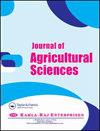The Relationships Between Propolis Collecting Capability and Morphometric Features of Some Honey Bee Races and Ecotypes in Anatolia
IF 0.7
Q3 AGRICULTURE, MULTIDISCIPLINARY
引用次数: 4
Abstract
Propolis collecting capacity of the honey bee race, Apis mellifera L., distributed across Anatolia and Thrace regions of Turkey was investigated and correlated with morphometric characteristics. Thus, the propolis collecting behaviour of honey bee races and ecotypes naturally have been in Turkey, Apis mellifera caucasica, Apis mellifera carnica, Apis mellifera syriaca and Yigilca and Mugla ecotype of Apis mellifera anatoliaca were monitored. The mean yield of annual propolis was recorded as the following; Yigilca ecotype (111.6±27.5 g colony) A. m. caucasica (104±20.7 g colony), Mugla ecotype (103±34 g colony), A. m. carnica (91.16±17.6 g colony), and A. m. syriaca (74±6.4 g colony) in descending order. The highest propolis collecting activity was recorded for the Yigilca ecotype of A. m. anatoliaca and A. m. caucasica. Morphological features of honey bee samples were evaluated by classic morphometric technique to correlate propolis collecting capability and morphological features. Morphometric results of the present study showed that the largest wing and leg lengths belonged to Yigilca ecotype of A. m. anatoliaca and A. m. caucasica. Furthermore, Pearson correlation showed a significant relationship between some morphometric characteristics including the proboscis and mandibular sections, wing length (WL), wing width (WW), femur length (FL), tibia length (TL), basitarsus length (BL), basitarsus width (BW), and propolis collecting capability (P<0.05). Therefore, it seems that the enlargement of certain morphological properties with genetic tendency of the honey bee races and ecotypes, primarily the legs and wings, can lead to better propolis collecting capability.安纳托利亚一些蜜蜂种和生态型的蜂胶收集能力与形态特征的关系
研究了分布在土耳其安纳托利亚和色雷斯地区的蜜蜂品种Apis mellifera L.的蜂胶收集能力及其与形态计量学特征的相关性。因此,对土耳其、高加索蜜蜂、卡尼卡蜜蜂、叙利亚蜜蜂、伊吉卡蜜蜂和阿纳托利卡蜜蜂的Mugla生态型进行了蜂胶采集行为的自然监测。每年蜂胶的平均产量记录如下:Yigilca生态型(111.6±27.5 g)、a.m. caucasica(104±20.7 g)、Mugla生态型(103±34 g)、a.m. carnica(91.16±17.6 g)、a.m. syriaca(74±6.4 g)。聚碳酸酯和白蚁的Yigilca生态型蜂胶收集活性最高。采用经典形态计量学方法对蜜蜂的形态特征进行评价,将蜂胶采集能力与形态特征相联系。本研究的形态测量结果表明,翼长和腿长最大的类群分别属于白种人类群和白种人类群的Yigilca生态型。Pearson相关分析显示,喙、下颌骨、翼长、翼宽、股骨长、胫骨长、基底骨长、基底骨宽与蜂胶收集能力之间存在显著相关(P<0.05)。因此,蜂种和生态型的某些具有遗传倾向的形态特征的扩大,主要是腿和翅膀,可能导致更好的蜂胶收集能力。
本文章由计算机程序翻译,如有差异,请以英文原文为准。
求助全文
约1分钟内获得全文
求助全文
来源期刊

Journal of Agricultural Sciences
AGRICULTURE, MULTIDISCIPLINARY-
CiteScore
1.80
自引率
0.00%
发文量
0
 求助内容:
求助内容: 应助结果提醒方式:
应助结果提醒方式:


